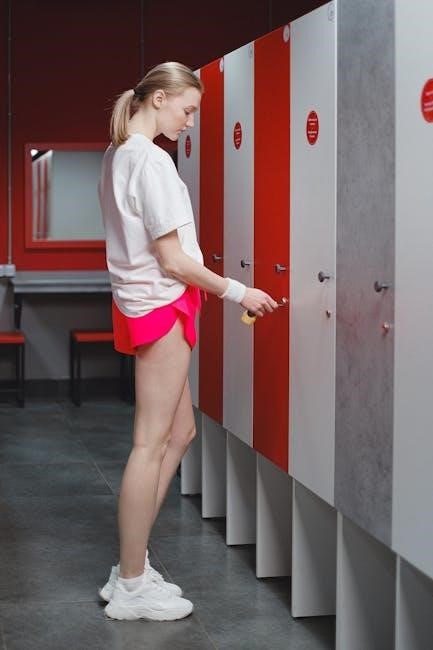A door closer is a mechanical device that automatically closes doors, ensuring security, fire safety, and convenience. Installation requires precision to guarantee proper functionality and durability.
Understanding the Purpose and Importance
A door closer ensures that doors close automatically, providing enhanced security, fire safety, and energy efficiency. Its primary function is to control the door’s movement, preventing unauthorized access and reducing heat or cool air loss. Proper installation is crucial for maintaining the integrity of the door system, ensuring smooth operation, and meeting safety standards. Door closers are essential in commercial and residential settings, offering convenience and reliability. They also help comply with fire safety regulations by automatically closing doors in emergencies. Understanding their purpose and importance is key to selecting the right type and installing it correctly for optimal performance and longevity.

Preparation for Installation
Preparation involves gathering tools, identifying the door closer type, and measuring door dimensions. Ensure alignment with hinges and frame, and mark pilot holes for secure mounting.
Gathering Necessary Tools
Installing a door closer requires specific tools for accuracy and efficiency. Essential tools include a drill with bits, screwdrivers, measuring tape, and a level. Additionally, a pencil for marking pilot holes and a wrench for adjustments are necessary. Ensure all tools are readily accessible to streamline the process. Proper tools prevent damage and ensure a secure fit. Refer to the manufacturer’s instructions for any specialized tools needed for your specific door closer model. Having everything prepared beforehand saves time and minimizes errors during installation.
Identifying Door Closer Type
Identifying the correct type of door closer is crucial for proper installation. Door closers vary, including concealed, surface-mounted, and sliding door closers. Concealed closers are hidden within the door or frame, while surface-mounted types are visible. Sliding door closers are designed for specific applications. Each type has unique installation requirements and adjustment features. Consult the manufacturer’s manual to determine the appropriate closer for your door weight and size. Understanding the closer’s mounting style, adjustment valves, and compatibility with your door ensures a successful installation. Proper identification prevents errors and guarantees the closer functions as intended for safety and convenience. Always match the closer type to your door’s specifications.
Door and Frame Preparation
Ensure the door and frame are properly aligned and structurally sound. Check for any damage or warping. Mark the closer’s mounting points accurately on both the door and frame for precise installation.
Drilling Pilot Holes
Drilling pilot holes is a critical step in door closer installation. Start by marking the screw locations on the door and frame using the manufacturer’s template. Use a drill bit slightly smaller than the screws to avoid splitting the material. For wood or metal doors, drill pilot holes to the recommended depth, ensuring they align perfectly with the closer’s mounting points. If using machine screws, you may need to drill and tap the holes. Properly aligned pilot holes ensure accurate screw placement, preventing damage to the door or frame. Use a level to double-check alignment for a secure and even installation. This step ensures a stable base for the door closer.
Mounting the Door Closer
Mounting the door closer involves securing the closer body to the door and frame. Ensure alignment with pilot holes and use provided screws for a firm attachment.
Positioning the Door Closer Body
Position the door closer body on the door or frame, ensuring alignment with pre-drilled pilot holes. The adjustment valves should face toward the hinge side for proper functionality. Secure the body using screws provided in the kit. Make sure it is level and tightly fastened to avoid any movement during operation. Proper positioning ensures smooth closing and prevents damage to the mechanism. Always refer to the manufacturer’s instructions for specific placement recommendations, as different models may have unique requirements.
Aligning Adjustment Valves
Properly aligning the adjustment valves ensures the door closer functions smoothly and consistently. Position the valves toward the hinge side of the door, as specified in the manufacturer’s instructions. This alignment allows precise control over closing and latching speeds. Secure the door closer body firmly to maintain the correct orientation of the valves. Misalignment can lead to uneven closing speeds or mechanical wear. Always refer to the specific model’s guidelines, as some door closers may require additional adjustments or unique positioning. Proper alignment is crucial for optimal performance and longevity of the door closer mechanism.

Installing the Arm Assembly
The arm assembly connects the door closer to the door frame, ensuring smooth operation. Attach the main arm to the door closer’s pinion shaft securely, following the manufacturer’s guidelines for proper alignment and torque specifications. This step is critical for the door closer’s functionality and durability, as incorrect installation can lead to mechanical failure or uneven door movement. Always refer to the specific model’s instructions for detailed mounting procedures and adjustment requirements. Proper installation of the arm assembly ensures the door closes consistently and maintains safety standards.
Attaching the Main Arm
Attaching the main arm is a critical step in door closer installation. Begin by aligning the arm with the pinion shaft on the door closer body. Secure it using the provided screw and washer, ensuring a tight fit to prevent any movement. Position the arm perpendicular to the door to maintain proper alignment. Use a wrench to tighten the screw firmly, but avoid over-tightening, which could damage the shaft. Once attached, check the arm’s alignment with the frame. Proper attachment ensures smooth door operation and prevents wear on the closer’s internal mechanisms. Always follow the manufacturer’s instructions for specific arm models and configurations.
Securing the Arm
Securing the arm is essential for ensuring the door closer functions properly. After attaching the main arm, tighten the screws firmly to prevent any movement. Use the provided washers to distribute the force evenly and avoid damaging the arm or the door. Align the arm correctly with the frame to maintain proper door operation. Apply the recommended torque to ensure a secure connection. Double-check the alignment and tighten any loose screws. Properly securing the arm prevents wear and tear on the closer’s internal mechanisms. Always refer to the manufacturer’s instructions for specific torque specifications and tightening sequences. This step ensures long-term reliability and smooth door operation.

Adjusting the Closing Speed
Adjusting the closing speed ensures smooth operation. Use the adjustment valves to regulate latch and sweep speeds according to manufacturer instructions for optimal door functionality and safety.
Setting Latch and Sweep Speeds
Setting the latch and sweep speeds is crucial for proper door closure. The latch speed controls how quickly the door closes near the latch, while the sweep speed manages the full closing motion. To adjust these, locate the adjustment valves on the door closer, typically positioned toward the hinge edge. Turn the valves clockwise to slow down the speed or counterclockwise to increase it. Ensure both speeds are balanced for smooth operation. Refer to the manufacturer’s instructions for specific guidance, as different models may vary slightly in adjustment mechanisms and recommendations. Proper adjustment ensures optimal functionality and longevity of the door closer system.
Testing the Installation
Test the door’s operation by opening and closing it fully to ensure smooth movement and proper closure. Verify the door aligns with the frame and latches securely.
Operating the Door
After installation, manually open and close the door to ensure smooth operation. Check that the door aligns properly with the frame and closes completely without resistance. Verify that the door closer’s adjustment valves are functioning correctly, allowing the door to latch securely. Test the door’s movement at various angles to confirm consistent closing speed and proper alignment. Ensure the door does not swing too forcefully or remain ajar. If necessary, fine-tune the adjustment valves to achieve the desired closing speed and latch action. Proper operation ensures safety, security, and longevity of the door and closer system.
Making Necessary Adjustments
After testing the door’s operation, adjustments may be needed for optimal performance. Locate the adjustment valves on the door closer, typically positioned near the hinge edge. Use an Allen wrench to fine-tune the latch and sweep speeds. Turning the valve clockwise slows the door’s closing speed, while counterclockwise increases it. Adjust one valve at a time, testing the door’s movement after each change. Ensure the door aligns properly with the frame and latches securely. Repeat adjustments until the door closes smoothly and consistently. Proper calibration ensures safety, security, and longevity of the door closer system.
Safety and Security Checks
Ensure the door closes securely and latches properly to maintain safety and security. Verify that all components are tightly secured and functioning correctly to prevent unauthorized access or accidents.
Ensuring Proper Function
After installation, test the door to ensure smooth operation. Check that the door closes fully and latches securely, verifying proper alignment and speed settings. Inspect all components, such as adjustment valves and arm assemblies, to confirm they are securely fastened and functioning as intended. Ensure the door closer’s valves are positioned correctly, with the speed adjustment facing the hinge side. Perform regular checks to maintain optimal performance and safety. If issues arise, refer to the manufacturer’s instructions for troubleshooting or adjustments. Proper functionality ensures the door closer meets safety standards and provides reliable operation over time.

Maintenance and Upkeep
Regular periodic inspections and lubrication of moving parts ensure longevity and smooth operation of the door closer, maintaining its efficiency and reliability over time.
Periodic Inspections
Regularly inspect the door closer for wear and tear, ensuring all screws are tightened and no parts are damaged. Lubricate hinge pins and adjustment valves to maintain smooth operation. Check the alignment of the arm assembly and verify that the door closes properly without resistance. Inspect the adjustment valves for correct positioning and functionality. Replace any worn-out components promptly to prevent malfunction. Ensure the door closer operates within its designed specifications, providing consistent closing speeds and secure latching. Addressing issues early prevents more costly repairs and ensures the door closer continues to function effectively over time.
